2005 Seat Ibiza 5D child restraint
[x] Cancel search: child restraintPage 30 of 252

Airbag system
28Airbag systemBrief introductionWhy wear a seat belt and assume the correct sitting position?
For the inflating airbags to achieve the best protection, the
sea t b el t m u st al w ay s b e w o rn p ro p e rly a nd t h e co rrec t s i tt i n g
position must be assumed.For your own safety and the safety of the passengers, please ensure
the following before you drive:
– Always wear the seat belt properly ⇒page 17.
– Adjust the driver seat and the steering wheel correctly ⇒page 9.
– Adjust the front passenger seat correctly ⇒page 10.
– Adjust the head restraint seat correctly ⇒page 12.
– Use the correct child restraint system to protect children in your vehicle ⇒page 43.The airbag deploys in fractions of a second and with a high velocity. If you
have assumed an incorrect seating po sition at that moment, you could
sustain critical injuries. Therefore, it is essential that all occupants maintain
a correct sitting position while travelling.
Braking heavily the moment before an accident may cause an occupant not
wearing a seat belt to be thrown forwar d into the area of the deploying airbag. In this case, the inflating airbag may infl
ict critical or fatal injuries upon the
occupant. This applies particularly to children.
Always maintain the greatest possible distance between yourself and the
front airbag. This way, the front airbags can completely deploy when trig-
gered, providing their maximum protection.
The most important factors for triggering the airbag are the type of accident,
the angle of impact and the vehicle speed.
Whether the airbags are triggered depends primarily on the vehicle deceler-
ation rate resulting from the collision an d detected by the control unit. If the
vehicle deceleration occurring duri ng the collision and measured by the
control unit remains below the specifie d reference values, the front, side
and/or curtain airbag will not be triggered. Take into account that the visible
damage in a vehicle following an accident, for whatever reason, are not an
indication as to why the airbags were triggered.
WARNING
•
Wearing the seat belt incorrectly or assuming an incorrect sitting posi-
tion can lead to critical or fatal injuries.
•
All occupants, including children, who are not properly belted can
sustain critical or fatal injuries if the airbag is triggered. You should always
transport all children up to 12 years of age on the rear seat. Never transport
children in the vehicle if they are not restrained or the restraint system is
not appropriate for their weight.
•
If you are not wearing a seat belt or if you lean forward or to the side or
assume an incorrect sitting position, the risk of injury is increased
substantially. This increased risk of injury will be further increased if you
are struck by an inflating airbag.
•
To reduce the risk of injury from an inflating airbag, always wear the
seat belt properly ⇒ page 17.
ibiza_ingles Seite 28 Mittwoch, 5. Oktober 2005 5:17 17
Page 36 of 252
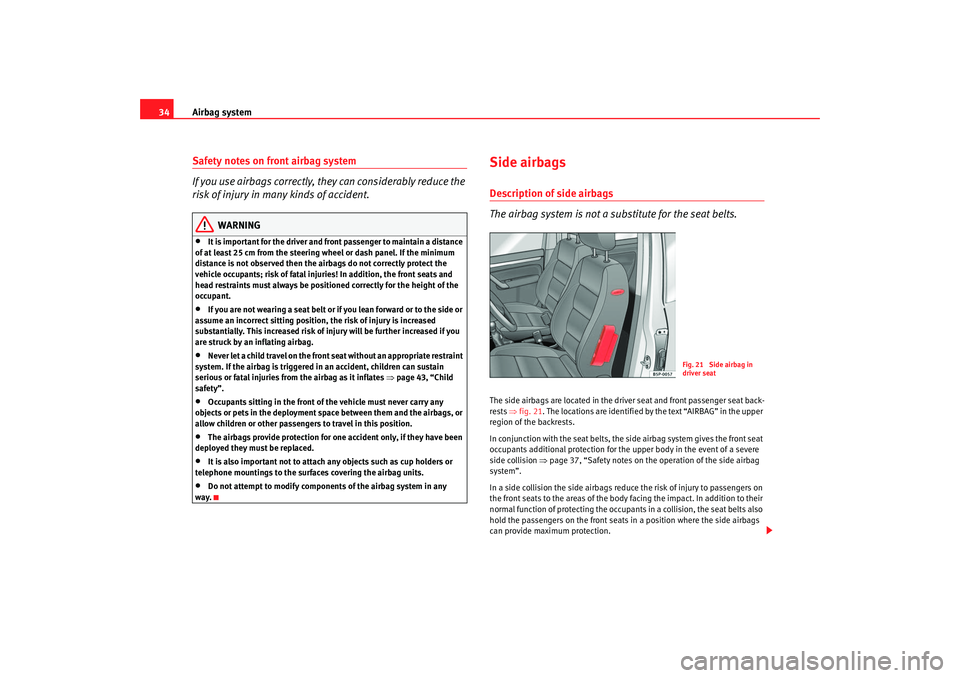
Airbag system
34Safety notes on front airbag system
If you use airbags correctly, they can considerably reduce the
risk of injury in many kinds of accident.
WARNING
•
It is important for the driver and front passenger to maintain a distance
of at least 25 cm from the steering wheel or dash panel. If the minimum
distance is not observed then the airbags do not correctly protect the
vehicle occupants; risk of fatal injuries! In addition, the front seats and
head restraints must always be positioned correctly for the height of the
occupant.
•
If you are not wearing a seat belt or if you lean forward or to the side or
assume an incorrect sitting position, the risk of injury is increased
substantially. This increased risk of injury will be further increased if you
are struck by an inflating airbag.
•
Never let a child travel on the front seat without an appropriate restraint
system. If the airbag is triggered in an accident, children can sustain
serious or fatal injuries from the airbag as it inflates ⇒page 43, “Child
safety”.
•
Occupants sitting in the front of the vehicle must never carry any
objects or pets in the deployment s pace between them and the airbags, or
allow children or other passenger s to travel in this position.
•
The airbags provide protection for one accident only, if they have been
deployed they must be replaced.
•
It is also important not to attach any objects such as cup holders or
telephone mountings to the surfaces covering the airbag units.
•
Do not attempt to modify components of the airbag system in any
way.
Side airbagsDescription of side airbags
The airbag system is not a substitute for the seat belts.The side airbags are located in the driver seat and front passenger seat back-
rests ⇒fig. 21 . The locations are identified by the text “AIRBAG” in the upper
region of the backrests.
In conjunction with the seat belts, the side airbag system gives the front seat
occupants additional protection for the upper body in the event of a severe
side collision ⇒page 37, “Safety notes on the operation of the side airbag
system”.
In a side collision the side airbags reduce the risk of injury to passengers on
the front seats to the areas of the body facing the impact. In addition to their
normal function of protecting the occupants in a collision, the seat belts also
hold the passengers on the front seats in a position where the side airbags
can provide maximum protection.
Fig. 21 Side airbag in
driver seat
ibiza_ingles Seite 34 Mittwoch, 5. Oktober 2005 5:17 17
Page 45 of 252
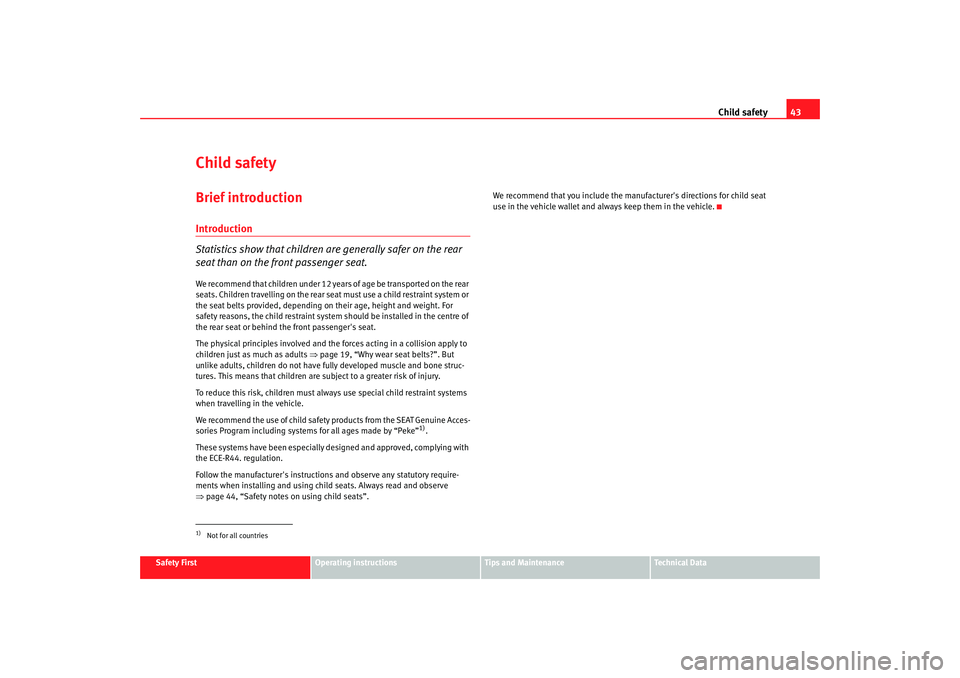
Child safety43
Safety First
Operating instructions
Tips and Maintenance
Te c h n i c a l D a t a
Child safetyBrief introductionIntroduction
Statistics show that children are generally safer on the rear
seat than on the front passenger seat.We recommend that children under 12 years of age be transported on the rear
seats. Children travelling on the rear seat must use a child restraint system or
the seat belts provided, depending on their age, height and weight. For
safety reasons, the child restraint system should be installed in the centre of
the rear seat or behind the front passenger's seat.
The physical principles involved and the forces acting in a collision apply to
children just as much as adults ⇒page 19, “Why wear seat belts?”. But
unlike adults, children do not have fully developed muscle and bone struc-
tures. This means that children are subject to a greater risk of injury.
To reduce this risk, children must always use special child restraint systems
when travelling in the vehicle.
We recommend the use of child safety products from the SEAT Genuine Acces-
sories Program including systems for all ages made by “Peke”
1).
These systems have been especially designed and approved, complying with
the ECE-R44. regulation.
Follow the manufacturer's instructions and observe any statutory require-
ments when installing and using child seats. Always read and observe
⇒ page 44, “Safety notes on using child seats”. We recommend that you include the manufacturer's directions for child seat
use in the vehicle wallet and always keep them in the vehicle.
1)Not for all countries
ibiza_ingles Seite 43 Mittwoch, 5. Oktober 2005 5:17 17
Page 46 of 252
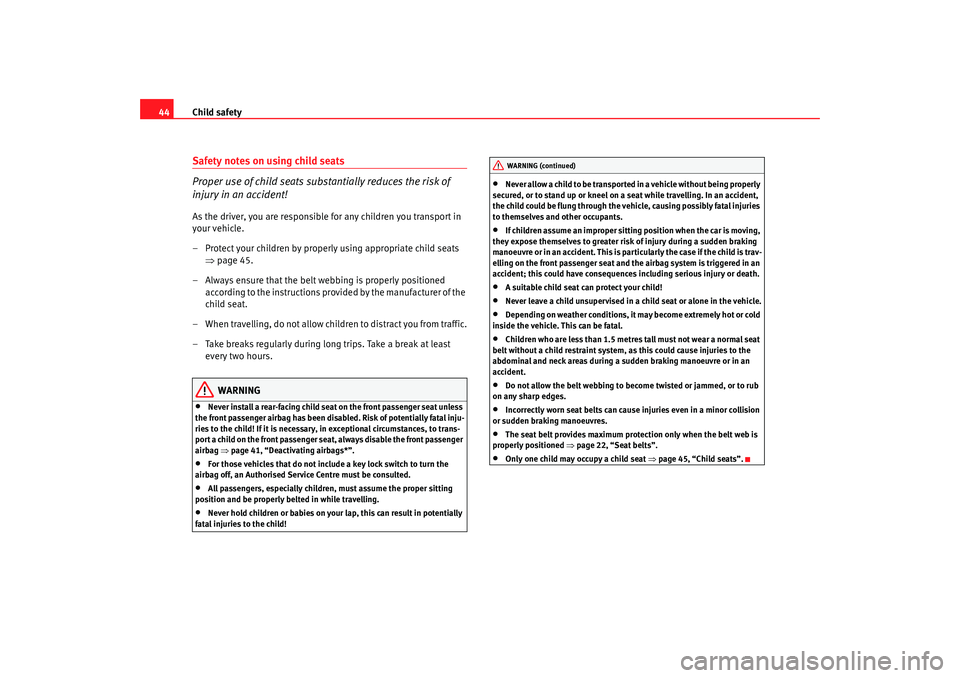
Child safety
44Safety notes on using child seats
Proper use of child seats substantially reduces the risk of
injury in an accident!As the driver, you are responsible for any children you transport in
your vehicle.
– Protect your children by properly using appropriate child seats
⇒page 45.
– Always ensure that the belt webbing is properly positioned according to the instructions prov ided by the manufacturer of the
child seat.
– When travelling, do not allow children to distract you from traffic.
– Take breaks regularly during long trips. Take a break at least every two hours.
WARNING
•
Never install a rear-facing child seat on the front passenger seat unless
the front passenger airbag has been disabled. Risk of potentially fatal inju-
ries to the child! If it is necessary, in exceptional circumstances, to trans-
port a child on the front passenger seat, always disable the front passenger
airbag ⇒ page 41, “Deactivating airbags*”.
•
For those vehicles that do not include a key lock switch to turn the
airbag off, an Authorised Service Centre must be consulted.
•
All passengers, especially children, must assume the proper sitting
position and be properly belted in while travelling.
•
Never hold children or babies on your lap, this can result in potentially
fatal injuries to the child!
•
Never allow a child to be transported in a vehicle without being properly
secured, or to stand up or kneel on a seat while travelling. In an accident,
the child could be flung through the vehicle, causing possibly fatal injuries
to themselves and other occupants.
•
If children assume an improper sitting position when the car is moving,
they expose themselves to greater risk of injury during a sudden braking
manoeuvre or in an accident. This is pa rticularly the case if the child is trav-
elling on the front passenger seat and the airbag system is triggered in an
accident; this could have consequences including serious injury or death.
•
A suitable child seat can protect your child!
•
Never leave a child unsupervised in a child seat or alone in the vehicle.
•
Depending on weather conditions, it may become extremely hot or cold
inside the vehicle. This can be fatal.
•
Children who are less than 1.5 metres tall must not wear a normal seat
belt without a child restraint system, as this could cause injuries to the
abdominal and neck areas during a sudden braking manoeuvre or in an
accident.
•
Do not allow the belt webbing to become twisted or jammed, or to rub
on any sharp edges.
•
Incorrectly worn seat belts can cause injuries even in a minor collision
or sudden braking manoeuvres.
•
The seat belt provides maximum prot ection only when the belt web is
properly positioned ⇒ page 22, “Seat belts”.
•
Only one child may occupy a child seat ⇒page 45, “Child seats”.WARNING (continued)
ibiza_ingles Seite 44 Mittwoch, 5. Oktober 2005 5:17 17
Page 48 of 252
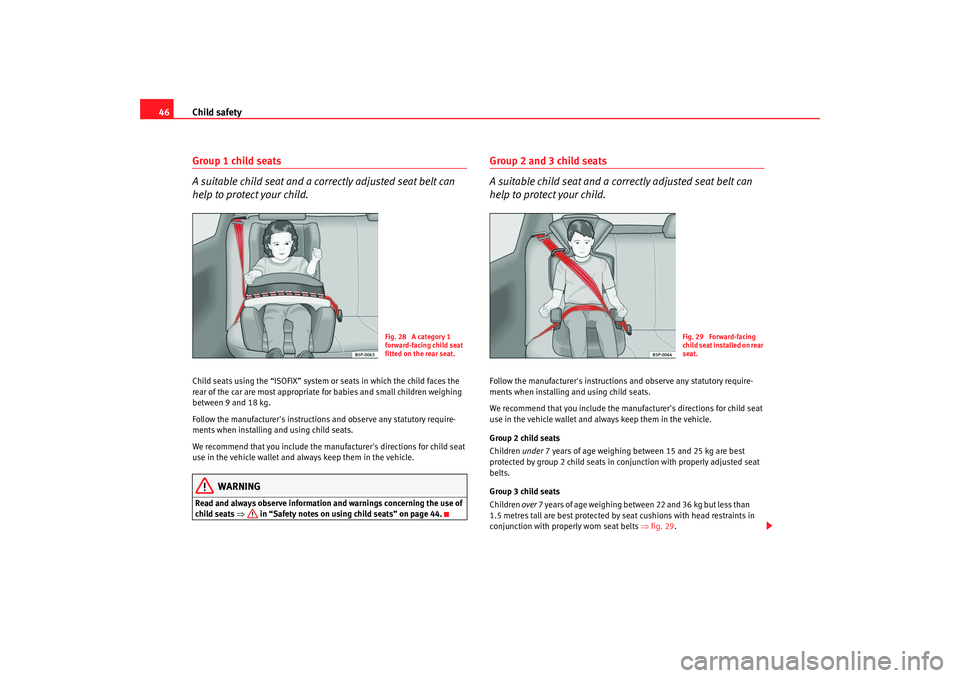
Child safety
46Group 1 child seats
A suitable child seat and a corr ectly adjusted seat belt can
help to protect your child.Child seats using the “ISOFIX” system or seats in which the child faces the
rear of the car are most appropriate for babies and small children weighing
between 9 and 18 kg.
Follow the manufacturer's instructions and observe any statutory require-
ments when installing and using child seats.
We recommend that you include the manufacturer's directions for child seat
use in the vehicle wallet and always keep them in the vehicle.
WARNING
Read and always observe information and warnings concerning the use of
child seats ⇒ in “Safety notes on using child seats” on page 44.
Group 2 and 3 child seats
A suitable child seat and a corr ectly adjusted seat belt can
help to protect your child.Follow the manufacturer's instructions and observe any statutory require-
ments when installing and using child seats.
We recommend that you include the manu facturer's directions for child seat
use in the vehicle wallet and always keep them in the vehicle.
Group 2 child seats
Children under 7 years of age weighing between 15 and 25 kg are best
protected by group 2 child seats in conjunction with properly adjusted seat
belts.
Group 3 child seats
Children over 7 years of age weighing between 22 and 36 kg but less than
1.5 metres tall are best protected by seat cushions with head restraints in
conjunction with properly worn seat belts ⇒fig. 29 .
Fig. 28 A category 1
forward-facing child seat
fitted on the rear seat.
Fig. 29 Forward-facing
child seat installed on rear
seat.
ibiza_ingles Seite 46 Mittwoch, 5. Oktober 2005 5:17 17
Page 50 of 252
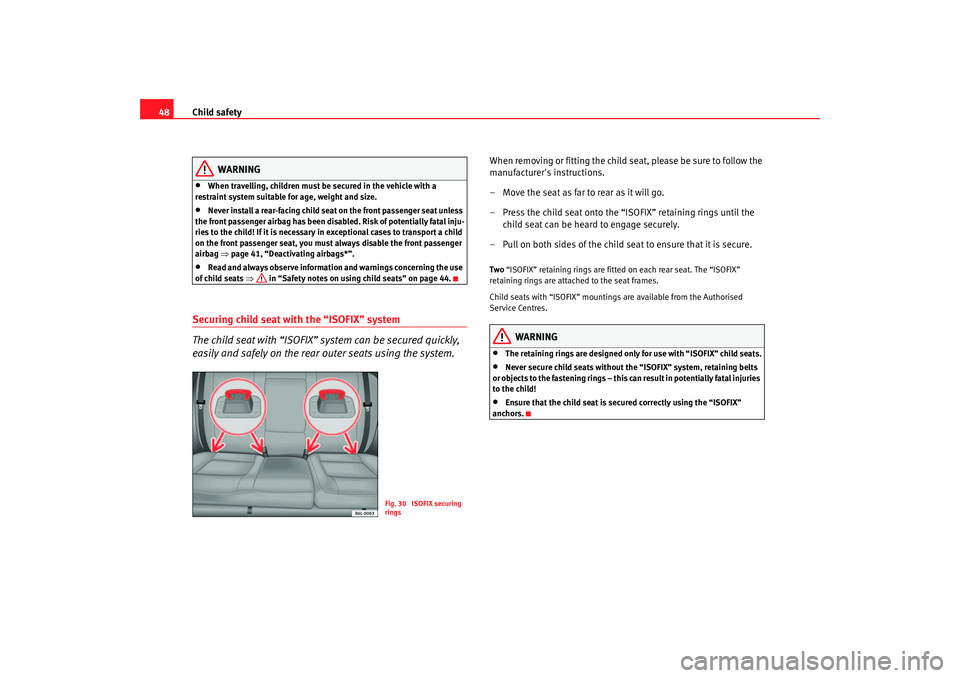
Child safety
48
WARNING
•
When travelling, children must be secured in the vehicle with a
restraint system suitable for age, weight and size.
•
Never install a rear-facing child seat on the front passenger seat unless
the front passenger airbag has been disabled. Risk of potentially fatal inju-
ries to the child! If it is necessary in exceptional cases to transport a child
on the front passenger seat, you must always disable the front passenger
airbag ⇒ page 41, “Deactivating airbags*”.
•
Read and always observe information and warnings concerning the use
of child seats ⇒ in “Safety notes on using child seats” on page 44.
Securing child seat with the “ISOFIX” system
The child seat with “ISOFIX” system can be secured quickly,
easily and safely on the rear outer seats using the system.
When removing or fitting the child seat, please be sure to follow the
manufacturer's instructions.
– Move the seat as far to rear as it will go.
– Press the child seat onto the “ISOFIX” retaining rings until the
child seat can be heard to engage securely.
– Pull on both sides of the child seat to ensure that it is secure.Two “ISOFIX” retaining rings are fitted on each rear seat. The “ISOFIX”
retaining rings are attached to the seat frames.
Child seats with “ISOFIX” mountings are available from the Authorised
Service Centres.
WARNING
•
The retaining rings are designed only for use with “ISOFIX” child seats.
•
Never secure child seats without the “ISOFIX” system, retaining belts
or objects to the fastening rings – this c an result in potentially fatal injuries
to the child!
•
Ensure that the child seat is se cured correctly using the “ISOFIX”
anchors.
Fig. 30 ISOFIX securing
rings
ibiza_ingles Seite 48 Mittwoch, 5. Oktober 2005 5:17 17
Page 102 of 252
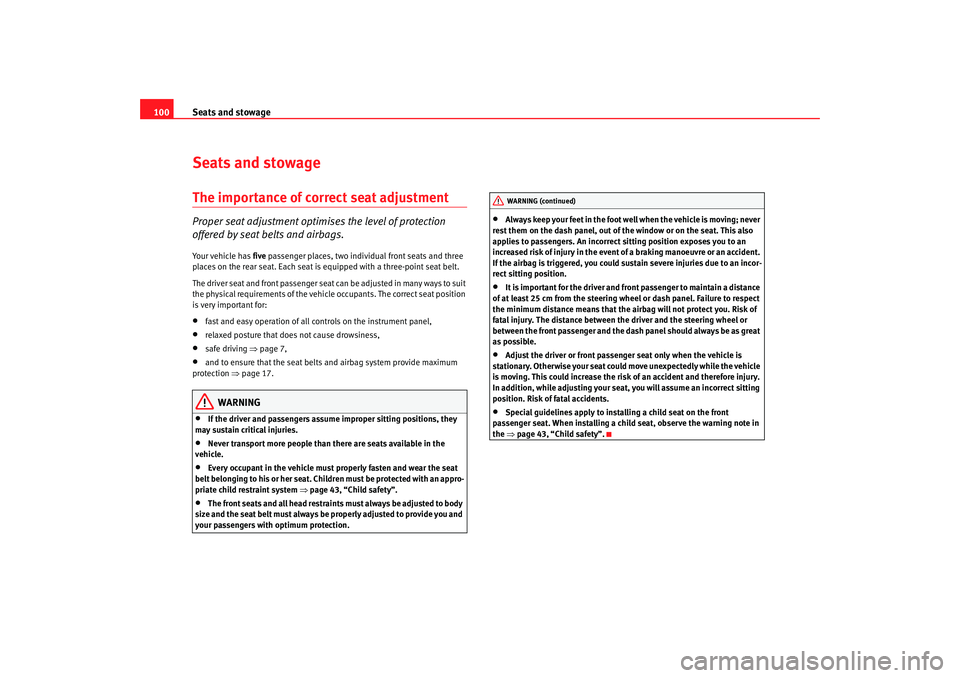
Seats and stowage
100Seats and stowageThe importance of correct seat adjustmentProper seat adjustment optimi ses the level of protection
offered by seat belts and airbags.Your vehicle has five passenger places, two individual front seats and three
places on the rear seat. Each seat is equipped with a three-point seat belt.
The driver seat and front passenger seat can be adjusted in many ways to suit
the physical requirements of the vehicl e occupants. The correct seat position
is very important for:•
fast and easy operation of all controls on the instrument panel,
•
relaxed posture that does not cause drowsiness,
•
safe driving ⇒page 7,
•
and to ensure that the seat belts and airbag system provide maximum
protection ⇒page 17.
WARNING
•
If the driver and passengers assume improper sitting positions, they
may sustain critical injuries.
•
Never transport more people than there are seats available in the
vehicle.
•
Every occupant in the vehicle must properly fasten and wear the seat
belt belonging to his or her seat. Children must be protected with an appro-
priate child restraint system ⇒page 43, “Child safety”.
•
The front seats and all head restraints must always be adjusted to body
size and the seat belt must always be properly adjusted to provide you and
your passengers with optimum protection.
•
Always keep your feet in the foot well when the vehicle is moving; never
rest them on the dash panel, out of the window or on the seat. This also
applies to passengers. An incorrect sitting position exposes you to an
increased risk of injury in the event of a braking manoeuvre or an accident.
If the airbag is triggered, you could sustain severe injuries due to an incor-
rect sitting position.
•
It is important for the driver and front passenger to maintain a distance
of at least 25 cm from the steering wh eel or dash panel. Failure to respect
the minimum distance means that the airbag will not protect you. Risk of
fatal injury. The distance between the driver and the steering wheel or
between the front passenger and the dash panel should always be as great
as possible.
•
Adjust the driver or front passenger seat only when the vehicle is
stationary. Otherwise your seat could move unexpectedly while the vehicle
is moving. This could increase the risk of an accident and therefore injury.
In addition, while adjusting your seat, you will assume an incorrect sitting
position. Risk of fatal accidents.
•
Special guidelines apply to installing a child seat on the front
passenger seat. When installing a chil d seat, observe the warning note in
the ⇒page 43, “Child safety”.WARNING (continued)
ibiza_ingles Seite 100 Mittwoch, 5. Oktober 2005 5:17 17
Page 245 of 252

Index243
Coolant temperature
Display . . . . . . . . . . . . . . . . . . . . . . . . . . . . . . 53
Safety instructions . . . . . . . . . . . . . . . . . . . . . 64
Correct adjustment of front head restraints . . . . 12
Cruise control system . . . . . . . . . . . . . . . . . . . . 135
Curtain airbags . . . . . . . . . . . . . . . . . . . . . . . . . . 38 Description . . . . . . . . . . . . . . . . . . . . . . . . . . . 38
Function . . . . . . . . . . . . . . . . . . . . . . . . . . . . . 39
Safety notes . . . . . . . . . . . . . . . . . . . . . . . . . . 39DDanger of fitting a child seat on the front passenger seat . . . . . . . . . . . . . . . . . . . . . . . . . . . . . . . 29
Diesel . . . . . . . . . . . . . . . . . . . . . . . . . . . . . . . . . 168
Diesel engine Winter driving . . . . . . . . . . . . . . . . . . . . . . . . 169
Differential lock . . . . . . . . . . . . . . . . . . . . . . . . . 142
Differential lock fault (EDL) warning lamp . . . . . . . . . . . . . . . . . . . . . . . . . 67
Digital clock . . . . . . . . . . . . . . . . . . . . . . . . . . . . . 54
Dipped headlights . . . . . . . . . . . . . . . . . . . . . . . . 88
Disabling front passenger airbag Safety notes . . . . . . . . . . . . . . . . . . . . . . . . . . 42
Disabling the airbag Disabling front passenger airbag . . . . . . . . . 41
Displays in the Multi-function display Memory displays . . . . . . . . . . . . . . . . . . . . . . 56
Door lock cylinders . . . . . . . . . . . . . . . . . . . . . . 157
Door release lever . . . . . . . . . . . . . . . . . . . . . . . . 51 Doors
Childproof locks . . . . . . . . . . . . . . . . . . . . . . . 74
Drive wheels traction control system . . . . . . . . 140
Driving Driving abroad . . . . . . . . . . . . . . . . . . . . . . . 145
With a trailer . . . . . . . . . . . . . . . . . . . . . . . . . 151
with a trailer . . . . . . . . . . . . . . . . . . . . . . . . . 149
Driving abroad . . . . . . . . . . . . . . . . . . . . . . . . . . 145 Headlights . . . . . . . . . . . . . . . . . . . . . . . . . . 145
Driving economically . . . . . . . . . . . . . . . . . . . . . 151
Driving safety . . . . . . . . . . . . . . . . . . . . . . . . . . . . . 8
Driving with respect for the environment . . . . . 151
Duplicate keys . . . . . . . . . . . . . . . . . . . . . . . . . . . 76
Dust filter . . . . . . . . . . . . . . . . . . . . . . . . . . . . . . 121
Dynamic headlight range control . . . . . . . . . . . . 89
EEDL . . . . . . . . . . . . . . . . . . . . . . . . . . . . . . . . . . . 142
EDS Warning lamp . . . . . . . . . . . . . . . . . . . . . . . . . 65
Electrical sockets . . . . . . . . . . . . . . . . . . . . . . . . 110
Electrohydraulic steering warning lamp . . . . . . . . . . . . . . . . . . . . . . . . . 63
Electronic differential lock . . . . . . . . . . . . . . . . 142 Warning lamp . . . . . . . . . . . . . . . . . . . . . . . . . 65
Electronic immobiliser . . . . . . . . . . . . . . . . . 66, 126
Electronic stabilisation program . . . . . . . . . . . 141
Electronic stabilisation programme . . . . . . . . . . 66 Description . . . . . . . . . . . . . . . . . . . . . . . . . . 124
Warning lamp . . . . . . . . . . . . . . . . . . . . . . . . 125 Electronic stabilisation programme (ESP)
warning lamp . . . . . . . . . . . . . . . . . . . . . . . . . 66
Emission control system warning lamp . . . . . . . . . . . . . . . . . . . . . . . . . 66
Engine Running in . . . . . . . . . . . . . . . . . . . . . . . . . . 143
Engine compartment Working in the engine compartment . . . . . 169
Engine coolant . . . . . . . . . . . . . . . . . . . . . . . . . . 176
Engine fault Warning lamp . . . . . . . . . . . . . . . . . . . . . . . . 63
Engine management Warning lamp . . . . . . . . . . . . . . . . . . . . . . . . 63
Engine oil . . . . . . . . . . . . . . . . . . . . . . . . . . . . . . 172 Changing . . . . . . . . . . . . . . . . . . . . . . . . . . . 176
Checking level . . . . . . . . . . . . . . . . . . . . . . . 174
Oil properties . . . . . . . . . . . . . . . . . . . . . . . . 173
Specifications . . . . . . . . . . . . . . . . . . . . . . . 172
Topping up . . . . . . . . . . . . . . . . . . . . . . . . . . 175
Engine oil dipstick . . . . . . . . . . . . . . . . . . . . . . . 174
Engine oil pressure Warning lamp . . . . . . . . . . . . . . . . . . . . . . . . 67
Environmental tip Avoiding pollution . . . . . . . . . . . . . . . . . . . . 167
ESP . . . . . . . . . . . . . . . . . . . . . . . . . . . . . . . . 66, 141
Exterior mirrors . . . . . . . . . . . . . . . . . . . . . . . . . 156
External aerial . . . . . . . . . . . . . . . . . . . . . . . . . . 163
FFastening rings . . . . . . . . . . . . . . . . . . . . . . 16, 111
ibiza_ingles Seite 243 Mittwoch, 5. Oktober 2005 5:17 17